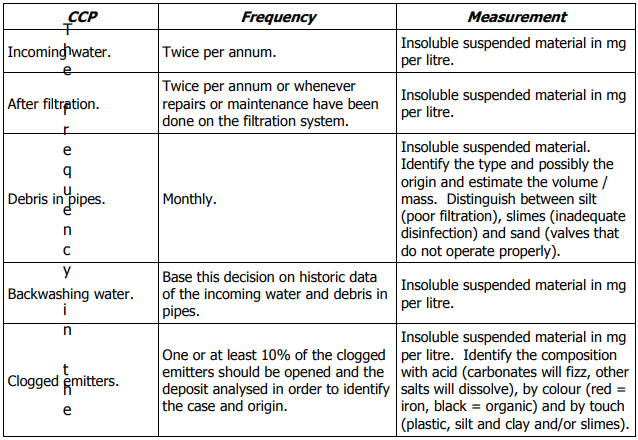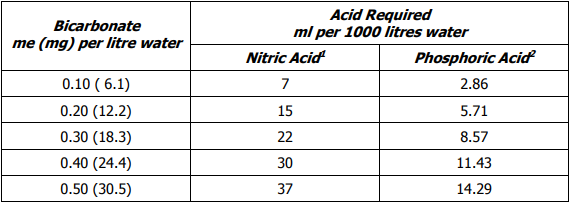A water quality management system needs to be developed according to the requirements of the irrigation system; the quality of the incoming water and the quality of water required at the trees. The requirements for a flood irrigation system will be much less stringent than with a drip irrigation system where water with almost no suspended solids and a pH of 6.50 is required.
To develop a management system, one has to identify the quality required, the improvements that can be made, sub-optimal quality factors that must be managed and what to measure to be in a position to manage the improvements and impact on the soil and trees.
The most common water quality processes that need to be managed with micro-irrigation are filtration, acidification and disinfection.
Filtration
The filtration process forms part of the irrigation system and is managed by the irrigation manager. However, specific points to measure the concentration of suspended solids must be identified, monitored, recorded and assessed continuously. These critical control points (CCP) must include:
- Incoming water
- Water after filtration
- Debris when flushing the pipes
- Water when backwashing the filters
- Clogged emitters
Measurements and recordkeeping of this data enable the manager to take corrective steps before an incident occurs that causes damage.

The frequency in the table above reflects the minimum. Recorded data, the quality of the incoming water and seasonal variation will determine the actual frequency. Remember, rather a too high than a too low frequency.
Acidification
Acidification is not always required when micro-irrigation is practised. It is usually required in open Hydroponic systems or other drip systems during July to September / October for citrus. Its use is determined by economic decisions and the added nitrogen, phosphorus or sulphur should form part of the total fertilisation program.
Managing the pH of the irrigation water can be done manually or continuously aided by a pH sensor and a computer. The acidification process of irrigation water can also be managed by recording the volume of water treated and the volume of acid used in the process. These volumes should add up to the estimated acid usage. The volume of acid is best to be determined by chemical titration. Otherwise, the volume can be calculated based on the concentration of carbonates and bicarbonates.
The volumes of nitric acid and phosphoric acid required to acidify irrigation water to pH 6.0-6.5 are based on the concentration of the bicarbonates.

- 60% with the normality of 13.7 and density of 1.36
- 285% with the normality of 36.4 and density of 1.69
When the volume of acid required is determined by titration, the volume to be added to the water can be calculated. Monitoring the acidification process can then be done as follows:



Choose the recordkeeping system that suits the requirements best, but ensure that it supplies the correct and sufficient information for management to optimise conditions and prevent any hazardous incident.
Instead of acids available commercially, buffer solutions can be applied. The advantages of buffer solutions are that it is safer to use and over dosing is less of a problem.
Disinfection
Disinfection can be done continuously or periodically. Measuring the concentration of the free chlorine at the most distant emitter, is the best method to ensure that the treatment was done on all emitters at an effective concentration. Additional information, such as mass hypochlorite applied and intervals of application can assist in managing the process.
Maintaining Quality In Water Quality Management Systems
The quality of any management system depends on the:
- Relevance of the measurements taken
- Accuracy of measurements
- Frequency of testing
- Frequency of data assessment
- Frequency of reporting
- Relevance of measurements
A management system can be killed by too much meaningless data. Too many measurements require time and effort and are the first thing to be neglected when time is limited. A few measurements that can be done quickly and accurately and that have meaningful input on the decision-making process should be selected.
The most appropriate measurements that can be done on the farm are pH and EC. Although the EC measurement cannot tell what type of salts is dissolved, in a management system it can tell the magnitude of changes. Comparing the latest EC measurement with that on record, including that of the laboratory report, indicates changes and whether additional actions or tests are justified. A hand-held module pH-meter or pH strips and an EC-meter that can be used in the orchards with ease should be available. Follow the instructions of the supplier to ensure accuracy.
Record the data immediately and/or transfer it to the database for water management. The concentration of suspended solids in the water is another simple measurement that can be included in the management system. Other important measurements are the concentration of sodium, chloride and boron, as well as the SAR. These can only be done in a laboratory and should form part of the report on the complete analyses of the water.
The quality of a water quality management system (WQMS) depends on what is done with the data and not how much data is collected. Collect data that can be used to optimise the production of citrus in a sustainable environment.
Accuracy of the Measurements
Measurements on the farm and in the orchard cannot be as accurate as those done in a laboratory. However, on-farm measurements should be accurate enough to give results similar to that of the laboratory. The procedures used on the farm should also include standard solutions for pH (pH-buffers) and EC. However, always strive to measure as accurately as possible without increasing the cost too much. Hand-held instruments that are calibrated regularly are usually very accurate. Laboratory results should be of a high standard.
Click here to view a video that explains what a buffer is.
Frequency of Testing
The quality and the variation in quality will dictate the frequency of testing. Water from a huge storage dam, such as the Gariep or Kwena dams, have a fairly constant composition and the frequency of testing will be below. The quality of irrigation water in a river like the Olifants River in the Lowveld is subjected to more fluctuations and will necessitate frequent testing. Historical data can be used to determine the frequency required to optimise WQM. If no data is available, start with a complete laboratory testing followed by weekly testing of pH and EC on the farm until enough data is collected to set a schedule.
Frequency of Data Assessment
Data is collected to optimise the application of the water. If it is not analysed and evaluated regularly, the whole WQMS is useless. The very reason for a WQMS is to monitor the quality so that actions can be taken before damage is done to the crop, the trees or the environment. In a sound WQMS, evaluation and assessment of data are done soon after logging the data into the recording system. If any change that can have an impact is detected, it should be reported immediately, even in a formally structured management system.
Frequency of Reporting
The reporting system depends on the management of the farm. On a small farming unit where the farm manager is also the water quality manager, reporting on and assessing the collected data can be the same process.
The frequency will also depend on the variations in the quality of the water. With few and insignificant changes, a report on water quality should be filed at least once a year.
Where the quality of the water changes more rapidly, the reporting should be scheduled to avoid disasters, to facilitate corrective or preventative actions and to ensure that the relevant people or departments get the message in time.
Maintaining water Quality Management Systems
A WQMS that is of relevance to optimise the irrigation system, production and environment, is maintained almost by the fact that is it being used continuously. When the quality of the water is poor or fluctuate, the operations are dependent on the information. The WQMS forms such an important part of the farming operations that its priority will greatly ensure that the system is maintained.
A system that is only used on an ad hoc basis will let the manager down when it is needed the most. This often happens with a constant supply of moderate or good quality water. Under such conditions, the measurements, recordkeeping and evaluations are neglected. For these reasons, a formal schedule should be compiled and senior management should enforce the maintenance thereof by requesting regular reporting according to a fixed schedule.
Fluctuations in the quality of the water depend to a large extent on the activities upstream. This information can also be used to determine the frequency of measurements and reporting. Industries letting effluent into the upstream can cause major fluctuations.
The minimum requirement is a laboratory report twice per annum, before and after the rainy season. Thereafter, the frequency will depend on the quality of the water and the type of irrigation.
In the third example in section 2 of chapter 2, the management system was neglected and not properly maintained. The problems experienced at that time were due to a poorly maintained system and not to a major change in the quality of the water. This incident could have been prevented if the quality management system, including frequent reporting, was maintained. The cost of replacing 13% of the drippers and the loss in production outweighs the cost of maintaining the WQMS.